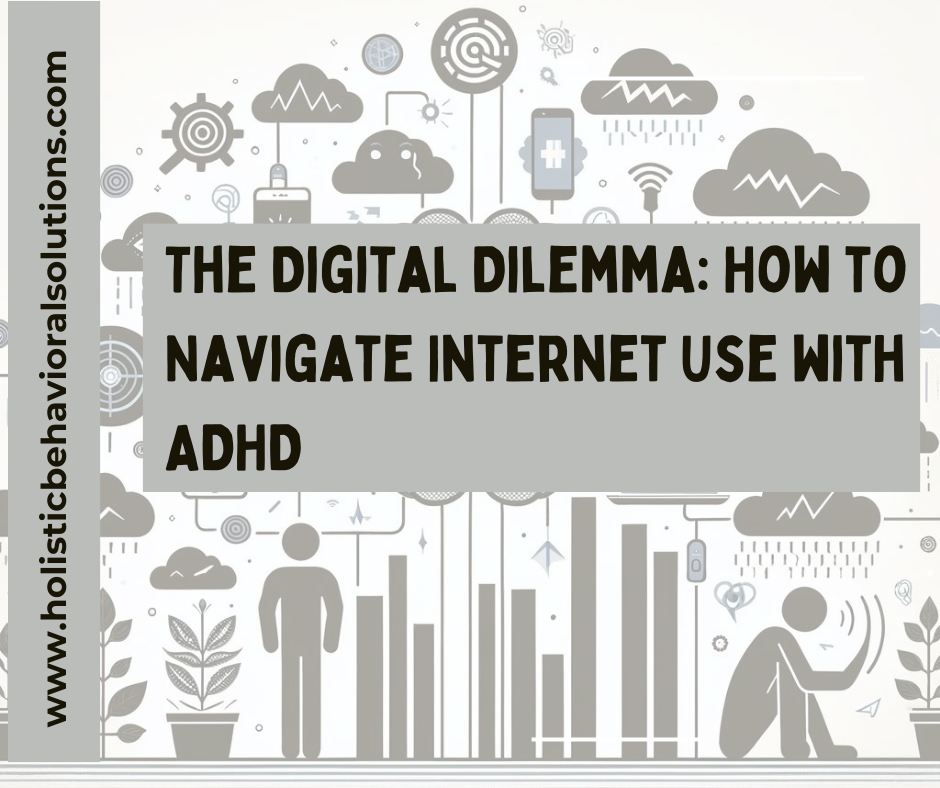
The Internet: We live in a time when our lives are deeply entwined with digital platforms. From the endless scroll on social media to the captivating worlds of online gaming, we’re constantly plugged in. Ironically, you are reading this while you are plugged in. For many, these platforms offer a way to connect, learn, and unwind. But what happens when our digital engagements begin to take a toll on our mental well-being? What happens to those living with The Digital Dilemma and Attention-Deficit/Hyperactivity Disorder (ADHD)?
A recent study sheds light on the question of balancing internet use with a diagnosis of ADHD. We focus on exploring the relationship between Problematic Internet use (PUI) and the quality of life for individuals with ADHD. The study looks at how digital habits intersect with psychological distress and overall life satisfaction; it offers insights for individuals, caregivers, and mental health professionals alike.
The ADHD and Internet Use Connection
ADHD is a neurodevelopmental disorder marked by symptoms such as inattention, hyperactivity, and impulsivity. It is important to note that ADHD is a spectrum disorder. These traits suggest a potential challenge in self-regulating internet use, leading to what’s termed PUI. The study looks at how uncontrolled digital engagement can exacerbate psychological distress, adding another layer of complexity to the everyday challenges faced by individuals with ADHD. I have heard people refer to this as the “ADHD Tax.”
Unraveling Psychological Distress and Quality of Life
One of the study’s primary findings is the role of psychological distress in the dynamic between PUI and quality of life (QoL). It appears that while specific digital activities have direct impacts on facets of QoL, it’s the overarching psychological distress that significantly shapes overall life satisfaction.
This insight sheds light on a critical aspect of digital well-being for those with ADHD: it’s not just the amount of time spent online but how this engagement affects mental health that matters.
The Role of Resilience
Interestingly, the study discovered a somewhat paradoxical role of resilience. On the one hand, individuals exhibiting higher resilience were less likely to seek mental health services, suggesting they might be managing their challenges independently. This trend was particularly noticeable among student-athletes and white students in the sample.
However, the protective veil of resilience seems to thin out as psychological distress intensifies. Beyond a certain threshold of mental health difficulties, even the most resilient individuals find themselves reaching out for support. This highlights a crucial point: Resilience is invaluable, but it’s equally important to recognize when to seek help.
Understanding the Needs of Diverse Groups
The study also unearthed significant insights into how race and athlete status influence digital engagement and mental health service utilization. Contrary to some prior research, students of color and white students reported similar rates of service utilization, suggesting a complex interplay of factors influencing these decisions.
Student-athletes, on the other hand, showed a lower tendency to use mental health services despite facing similar levels of mental health challenges as their non-athlete peers. This finding points to a significant gap in support for student-athletes, underscoring the need for targeted mental health interventions in athletic programs.
A Call for Compassionate Action
The study’s revelations underscore the urgent need for tailored programs aimed at mitigating PUI among individuals with ADHD. By fostering healthier digital habits and providing support for managing psychological distress, we can enhance the quality of life for those living with ADHD in our hyper-connected world.
As we navigate our digital engagements, it’s crucial to remain mindful of their impact on our mental well-being. For individuals with ADHD, striking a balance between the benefits and potential pitfalls of internet use is key to maintaining a healthy, fulfilling life. Remember, building and sustaining healthy habits is the cornerstone of a robust therapeutic treatment plan.
Embracing Our Shared Humanity in the Digital Age
As we digest these findings, let us remember the human stories behind the data. Each statistic represents individuals navigating the complexities of ADHD in a world where our digital and offline lives are increasingly intertwined. This shifting back and forth may be initially easier for those with ADHD but over time, it can lead to lower levels of life satisfaction.
This study not only contributes valuable insights to the field of mental health but also serves as a reminder of our shared humanity and need for emotional connectivity. In our fast-paced digital world, let’s commit to supporting each other, fostering resilience, and creating inclusive spaces where everyone can thrive, both online and offline.
In the end, it’s about finding harmony in our digital engagements, ensuring that our online activities enrich rather than diminish our quality of life. For individuals with ADHD, this means crafting a digital world that acknowledges their unique challenges and supports their journey toward well-being. Together, we can navigate the digital dilemma, ensuring that technology serves as a bridge to a more connected, compassionate world.
The Digital Dilemma and the Holistic Store
While we consider that, boost your connection from the inside out with our wellness supplements and supplies. Check out our store for products that help you feel your best, making it easier to open up and connect on a deeper level.
PS: Are you a culturally competent licensed clinician passionate about guiding others toward resilience? Our practice is growing, and we’re hiring in New Jersey! Check out our Careers page for current openings and join a team dedicated to fostering impactful, inclusive mental health support.

